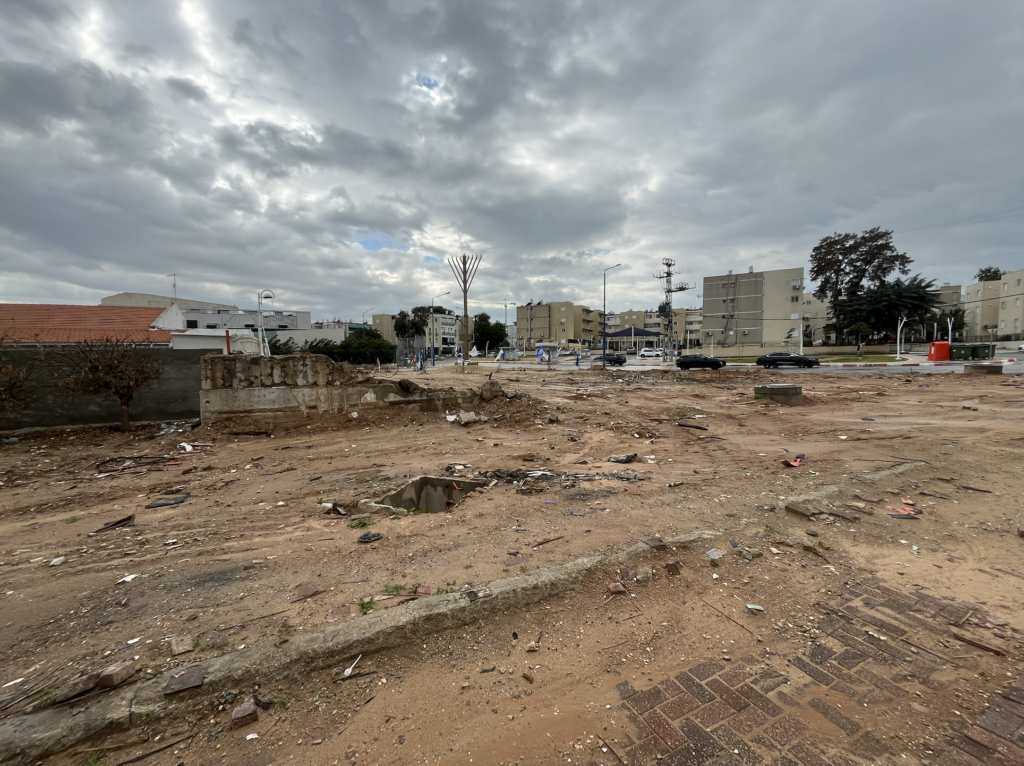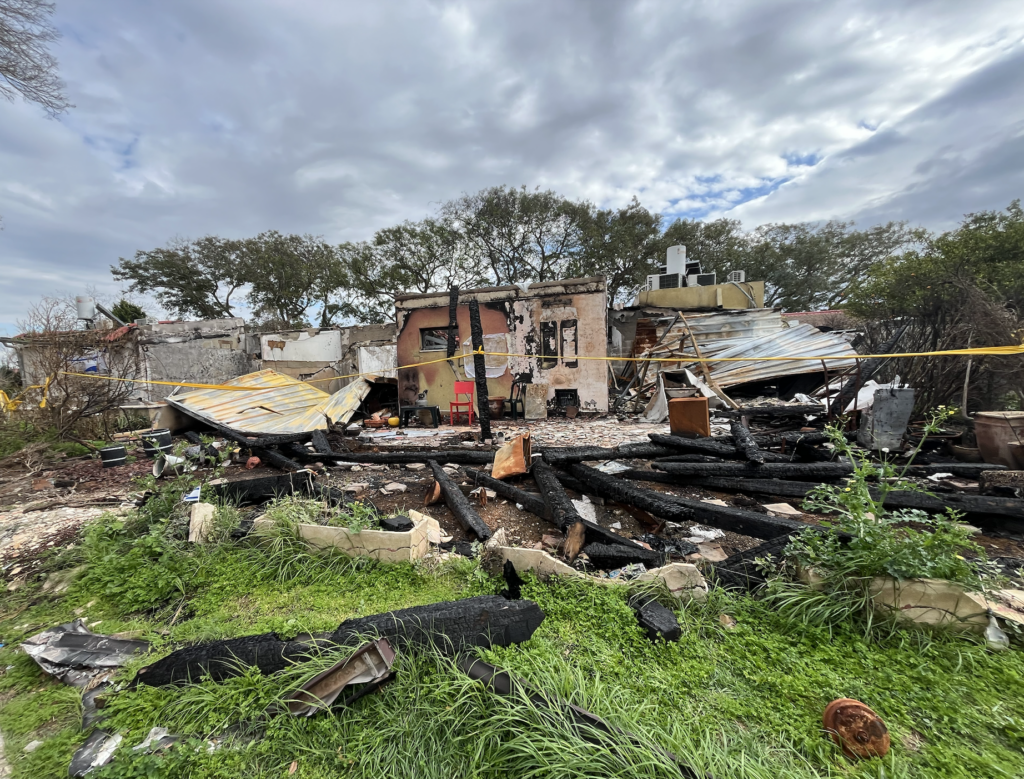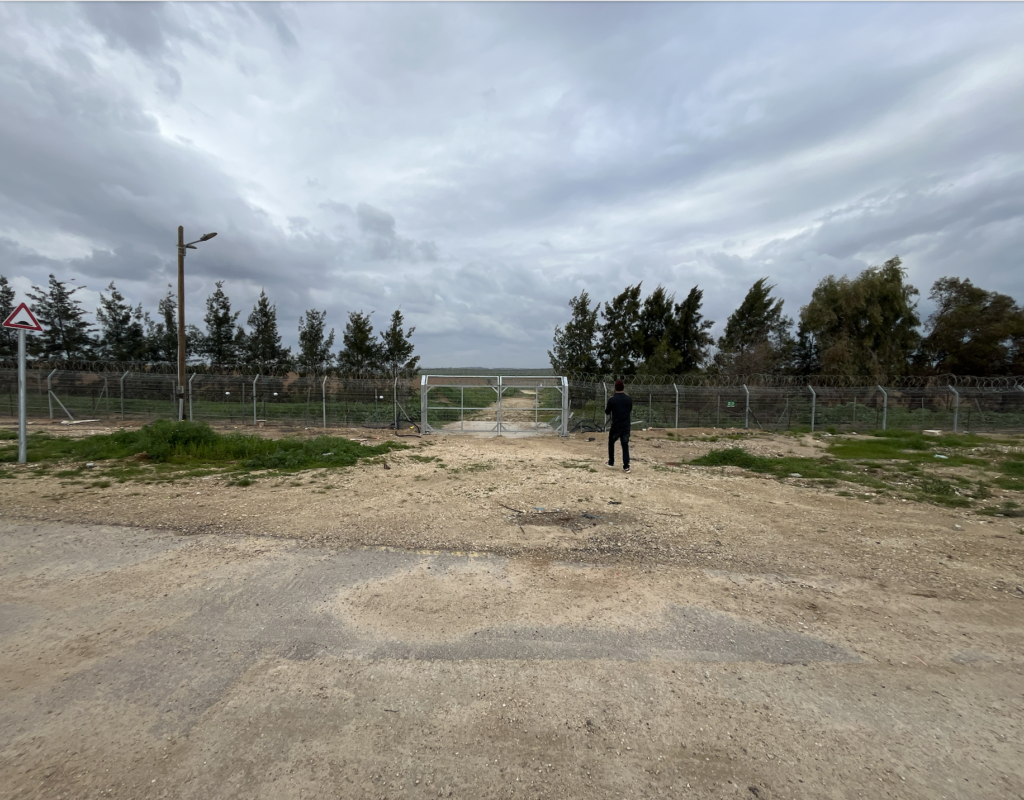“I can’t believe we’re going to the place where the most horrible thing happened, and it’s an hour from here,” Yael says.
“When it started, we were like, ‘Holy crap!’” Avi says. “Then we got used to it.”
Avi continues driving south, from Tel Aviv to Sderot, a place most people first learned about on October 7. Videos of the white pickup trucks arriving on a Saturday morning were unremarkable, except for the men in the back with assault rifles. We would learn that some also carried cameras, as a reminder of what they had come to do. As one headline later read: “They are all dead.”
“This is where the police station used to be,” Avi says of a dirt lot dotted with an air conditioner-sized pit. For the rest there is no trace of recent homes, no commemoration of the firefight that lasted hours on the stairs and on the roof. Seven station officers and an unknown number of Hamas militants were dead when the Israeli army gave the order: hit the station with tank fire.
“There was one terrorist left in the building,” Avi says. “Israeli forces demolished it, with him inside.”


“We tend to burn things to the ground,” Yael says, as she and Avi move down what was once a busy shopping street. Every wall here is pockmarked with bullet holes, broken window glass has not been replaced and what appears to have been a residence is missing its facade, exposing an overturned sink and a pile of clothes. The only other two people on the street assure that the blood of the 50 civilians killed here on October 7th has all been washed away. Yet the city seems ghostly, abandoned. Life and death are frozen here, if not a mile away in Gaza.
“They’re coming from Israeli guns,” Avi says of the explosions that make people stop and look up, or how many people there are: Ninety percent of Sderot’s 40,000 residents fled after the massacre, and fewer than 15,000 have returned.
“All seven dead policemen ate here,” says the owner of a shawarma café, the only shop open nearby. “Every day we hear about another customer who has died.”
“We were at home watching TV when it happened,” says his wife, who heard the shots and screams on Oct. 7 but refused to believe it was happening.
“I closed the window,” he says. Her husband opened it and they did so several times until they left Sderot that day, returning only three months later.
“It’s the first and last time I leave. I won’t let Hamas win,” says the husband, adding that the owner of the sporting goods store next door went out jogging on the morning of October 7 and was murdered .
Avi returns to the road, the same road where hundreds of young people fled for their lives, abandoned their cars and were massacred on the spot or marched at gunpoint into white pickup trucks.
“We were sleeping, a deep, deep, deep sleep,” he says of what is evident: that Israel was not ready for the assault; he had become complacent, even arrogant, relying too much on his intelligence and the Iron Dome.
“How many people have been hiding in the trees here and pretending to be dead?” Yael asks as they pass through fields thick with banana, lemon and avocado trees. Today traffic is normal, no sign of carnage.
“Incredible,” Avi says softly, seeing army trucks guarding a newly secured area, something that would never have happened before October 7. The Nova festival was a rave in an avocado grove, for God’s sake. Looking for something to be happy about, Yael points to some tiny red flowers poking out of the mud.
These will prove to be the only happy things for the next hour, or for as long as people remain at the memorial to the 364 dead young men, who have no choice but to remain here, to be remembered at or near the site of place where they were killed. , stabbed, beaten, burned. It’s tempting to say this is the worst thing, and it is the worst thing. But there are other things worse, including, one imagines, being asked to provide a photo of your dead daughter, to represent everything you know and love about her. This photo will be posted on a pole and sunk into the earth. It will be decorated by you, perhaps by others, with the usual totems: flowers, candles, aphorisms. You could try to make it personal, as you can see others have done for their murdered loved ones, with a rubber band, a keyboard, a karate medal. But the question is: how do you choose the photo? Is it the one of her at age 5, with her hands clenched into fists as she stands in front of a plate of cookies? Is it your high school diploma? Is it the most recent one of her, on stage accepting an award, with her hair shining like a mirror and all the life it took her to deserve that award making her shine? And if you can decide, how do you leave her alone in that field? How can you not huddle around the pole every night and say, “Leave me here. I’ll stay here.”
Avi and Yael prepare for their next stop, a place that is, if not worse, then at least differently ugly: the kibbutz where Hamas and others from Gaza broke through a fence on October 7, killing 63 people and kidnapping 18 others.
“You have 10 seconds to take cover if we hear an alarm, to run to a safe room or lie down on the ground with your hands above your head,” says Ron, the young IDF officer touring the now-empty Kibbutz Kfar Aza of its 950 inhabitants. Grapefruits the size of soccer balls rot on the ground, children’s bicycles lie abandoned in yards with miniature camel figurines, and yellow tape surrounds the worst locations of the October 7 attacks, some marked with colored symbols: blue means bomb squads cleared the ground. house, a red number indicates how many bodies were found inside. Ron assures visitors that “all the body parts are gone and the birds are back too.”
A bougainvillea grows outside the home of a newlywed couple who were burned alive in their safe room. The cycle of nature growing, of healing and oblivion, seems at once hopeful and obscene.


The air smells of burnt wood and something else: gunpowder.
A sign reads: “Human remains on the couch.” In Kfar Aza pic.twitter.com/LsRenwj07c
— Nancy Rommelmann (@NancyRomm) January 28, 2024
Avi approaches the fence through which the terrorists entered and where, according to Ron, they returned with all the loot they could: flat screens, cell phones and shoes taken from the women they had just killed.


“We knew everything about everything, but we didn’t know that,” Avi says, meaning the military planning Hamas was capable of and how much it was willing to risk to massacre its neighbors. more than three months later, they reverberate every few minutes with the bombing of Gaza by Israeli forces, creating what Avi calls “the symphony of war.”
Returning to the car, he and Yael hear another note of the symphony, the muffled “pop” of the Iron Dome intercepting a rocket coming from Gaza. Yael looks at the streaks he leaves in the sky, thinks about commenting and then doesn’t.